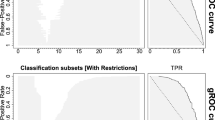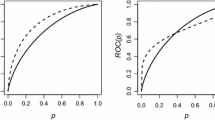Abstract
The phenomenon of the limit of detection (LoD) often happens in many practical situations because of technique and instrument limitations. In the literature, some reports show that, in general, to apply conventional methods to evaluate the diagnostic power of variables while ignoring LoD could be seriously biased. Although the area under the receiver operating characteristic (ROC) curve can be estimated consistently if the distribution of variables are known. In practical situation, such information is usually not available. On the other hand, it has been proved that the area under ROC curve of a variable with a LoD and no distribution assumptions is usually biased no matter what kinds of replacement strategies are used. However, there is a lack of similar studies on the partial area under ROC curve (pAUC), and because this measure is usually preferred in practice, it is of interest to examine whether the estimate of pAUC of a variable measured with a LoD behaves the same. In this study, we found that for some LoD scenarios, and even without distribution assumption, consistent estimate of pAUC can be constructed. When the consistent estimate of pAUC cannot be obtained, the bias can be ineffectual in practical situations, and the proposed estimator can be a good approximation of pAUC. Numerical studies using simulated data sets and real data examples are reported.




Similar content being viewed by others
References
Armbruster DA, Pry T (2008) Limit of blank, limit of detection and limit of quantitation. Clin Biochem Rev 29(Supple 1):S49–S52
Bache K, Lichman M (2013) UCI machine learning repository [http://archive.ics.uci.edu/ml]. University of California, School of Information and Computer Science 2013, Irvine
Cai T, Dodd LE (2008) Regression analysis for the partial area under the ROC curve. Stat Sin 18:817–836
Davatchi F, Shahram F, Nadji A, Chams-Davatchi C, Shama H, Akhkaghi M, Abdollahi BS, Ziaie N (2006) Performance of existing diagnosis/classification criteria for Behcet’s Disease in Iranian patients: analysis of 5666 patients and 2406 controls. APLAR J Rheumatol 9:238–243
Faraggi D, Reiser B (2002) Estimation of the area under the ROC curve. Stat Med 21:3093–3106
Jiang Y, Metz CE, Nishikawa RM (1996) A receiver operating characteristic partial area index for highly sensitive diagnostic tests. Radiology 201:745–750
LaFleur B, Lee W, Billhiemer D, Lockhart C, Liu J, Merchant N (2011) Statistical methods for assays with limits of detection: serum bile acid as a differentiator between patients with normal colons, adenomas, and colorectal cancer. J Carcinog 10:12
Mumford SL, Schisterman EF, Vexler A, Liu A (2006) Pooling biospecimens and limits of detection: effects on ROC curve analysis. Biostatistics 7:585–598
Park LJ (2005) Learning of neural networks for fraud detection based on a partial area under curve. In: Advances in neural networks V ISNN 2005 second international symposium on neural networks, Chongqing, China, May 30–June 1, 2005, Proceedings, Part II. Lecture notes in computer science, Springer, Berlin, 3497, pp 922–927
Perkins NJ, Schisterman EF, Vexler A (2011a) ROC curve inference for best linear combination of two biomarkers subject to limits of detection. Biom J 53:464–476
Perkins NJ, Schisterman EF, Vexler A (2011b) Receiver operating characteristic curve inference from a sample with a limit of detection. J Epidemiol 165:325–333
Ramana BV, Prasad Babu MS, Venkateswarlu NB (2011) A critical study of selected classification algorithms for liver disease diagnosis. Int J Database Manag Syst 3:101–114
Ramana BV, Prasad Babu MS, Venkateswarlu NB (2012) A critical comparative study of liver patients from USA and India: an exploratory analysis. Int J Comput Sci Issues 9:506–516
Thompson IM, Resnick MI, Klein EA (2001) Prostate cancer screening. Humana Press, New York
Thompson IM, Chi C, Ankerst DP, Goodman PJ, Tangen CM, Lippman SM, Lucia MS, Parnes HL, Coltman CA Jr (2006) Effect of finasteride on the sensitivity of PSA for detecting prostate cancer. J Natl Cancer Inst 98:1128–1133
Vexler A, Liu A, Eliseeva E, Schisterman EF (2008) Maximum likelihood ratio tests for comparing the discriminatory ability of biomarkers subject to limit of detection. Biometrics 64:895–903
Walter SD (2005) The partial area under the summary ROC curve. Stat Med 24:2025–2040
Wang Z, Chang YCI, Ying Z, Zhu L, Yang Y (2007) A parsimonious threshold-independent protein feature selection method through the area under receiver operating characteristic curve. Bioinformatics 23:2788–2794
Wang Z, Chang YCI (2012) Marker selection via maximizing the partial area under the ROC curve of linear risk scores. Biostatistics 12:369–385
Zhang DD, Zhou XH, Freeman DH, Freeman JL (2002) A nonparametric method for the comparison of partial areas under ROC curves and its application to large health care data sets. Stat Med 21:701–715
Acknowledgments
The authors are grateful to the Editor, the Associate Editor, and the anonymous referees for comments and suggestions that lead to improvements in the paper. Wang’s work is supported by funds of the State Key Program of National Natural Science of China (No. 11231010) and National Natural Science of China (No. 11471302).
Author information
Authors and Affiliations
Corresponding author
Appendix
Appendix
Proof of Theorem 2.1
From (2) and (5), we know that
where \(c=S_{\bar{D}}^{-1}(u)\) and \(c^*=S_{\bar{D*}}^{-1}(u)\) are \(1-u\) quantiles of X and \(\tilde{X}\), respectively. By total probability formula, we have
By the definitions of \(\widetilde{X}\) and \(\widetilde{Y}\), we know that \(\widetilde{X}=r\) and \(\widetilde{Y}=r\) when \(X<d\) and \(Y<d\). Then components of (9) can be rewritten as
(1) When \(S_{\bar{D}}(d)>u\) and \(S_{\bar{D*}}(d) > u\), both of \(c=S_{\bar{D}}^{-1}(u)\) and \(c^*=S_{\bar{D*}}^{-1}(u)\) are not smaller than the lower bound d. Therefore, it follows from definition of quantile and continuous property of X that \(c=c^*\ge d\). Thus, from continuous properties of X and Y and \(r\le d\), we have \(I={I^*}\), \(J={J^*}=0\), \(K={K^*}=0\), \(L={L^*}=0\), which suggests \(pAUC^*(u)={pAUC(u)}\).
(2) When \(S_{\bar{D}}(d)>u\) and \(S_{\bar{D*}}(d)<u\), the inequality \(c>d>c^*\) holds. Thus, \(I^*>I\), \(J=0\), \({J^*}\ge 0\), \(K^*=K=0\), \(L=0\), \({L^*}\ge 0\). Hence, we get \(pAUC^*(u)-{pAUC(u)}>0\). Similarly, If \(S_{\bar{D}}(d)<u\) and \(S_{\bar{D*}}(d)>u\), then \(c<d<c^*\) and \(pAUC^*(u)-{pAUC(u)}<0\). In conclusion, under situation (2), \(|pAUC^*(u)-{pAUC(u)}|>0\).
(3) When \(S_{\bar{D}}(d)<u\) and \(S_{\bar{D*}}(d)<u\), we have \(c<d\) and \(c^*<d\). This situation can be splitted into two parts, (i) \(c^*\le c<d\) and (ii) \(c<c^*<d\).
If (i) holds, then \(I=I^*,~J<J^*,~K=K^*=0,~L<L^*\), which indicates that \(pAUC^*(u)-{pAUC(u)}>0\). And if (ii) holds, then \(I={I^*},~J\le J^*,~K={K^*}=0\) and \(L<{L^*}\). So \((pAUC^*(u)-{pAUC(u)})>0\). Hence, the conclusion holds. \(\square \)
Proof of Theorem 2.2
Similar to proof of Theorem 2.1, we have
where \(c=S_{\bar{D}}^{-1}(u)\) and \(c^*=S_{\bar{D*}}^{-1}(u)\) are \(1-u\) quantiles of X and \(\tilde{X}\), respectively. By total probability formula, we have
By the definitions of \(\widetilde{X}\) and \(\widetilde{Y}\), we know that \(\widetilde{X}=r\) and \(\widetilde{Y}=r\) when \(X>d\) and \(Y>d\). Then components of (12) can be rewritten as
(1) When \(S_{\bar{D}}(d)<u\), \(c=S_{\bar{D}}^{-1}(u)\) is smaller than d and then \(c^*=c\). Therefore, \({I^*}=P(Y\ge d,X\ge d)\), \({J^*}=P(X\ge c|Y\ge d,X\le d)P(Y\ge d,X\le d)\), \({K^*}=0\) and \({L^*}=P(Y\ge X, X\ge c|Y\le d,X\le d)P(Y\le d,X\le d)\), which suggests that \({pAUC^*(u)}\) is free of choice of the replacement value r and is a constant. Moreover, by Eq. (11), \({pAUC^*(u)}-pAUC(u)= P(Y\ge d,X\ge d)-P(Y\ge X,X\ge c|Y\ge d,X\ge d)P(Y\ge d,X\ge d) =P(Y<X,Y\ge d,X\ge d)\).
(2) when \(S_{\bar{D}}(d)>u\), \(c^*=r\) and \({I^*}=P(Y\ge d,X\ge d)\), \({J^*}=0\), \({K^*}=0\) and \({L^*}=P(Y\ge X, X\ge r|Y\le d,X\le d)P(Y\le d,X\le d)=0\). So the \({pAUC^*(u)}=P(Y\ge d,X\ge d)\) becomes a constant not varying with the replacement value r. Hence, the conclusion holds. \(\square \)
Rights and permissions
About this article
Cite this article
Jia, B., Chang, Yc.I. & Wang, Z. Assessing the diagnostic power of variables measured with a detection limit. Comput Stat 31, 1287–1303 (2016). https://doi.org/10.1007/s00180-015-0628-0
Received:
Accepted:
Published:
Issue Date:
DOI: https://doi.org/10.1007/s00180-015-0628-0




